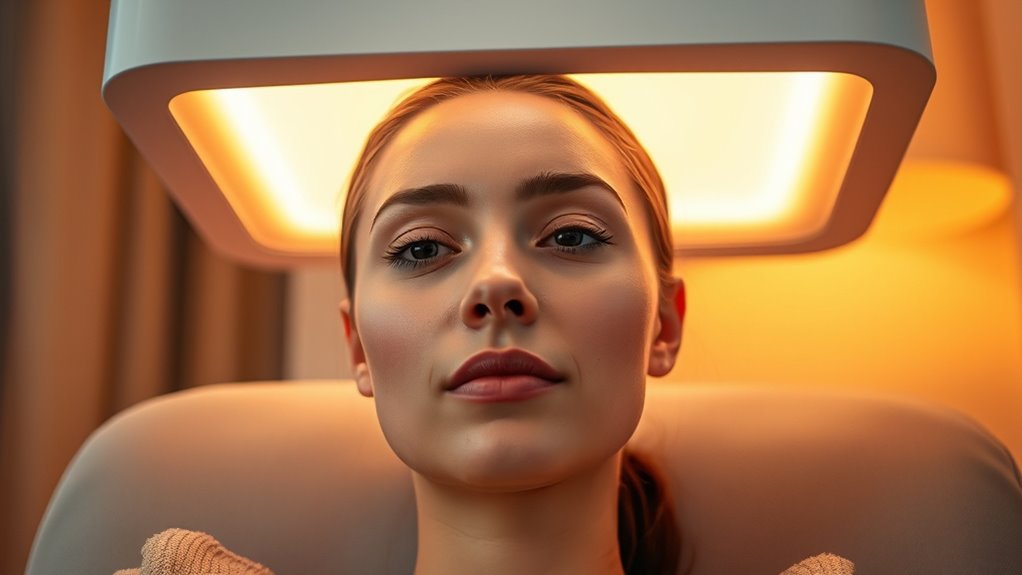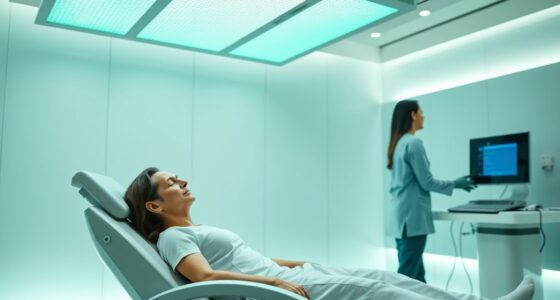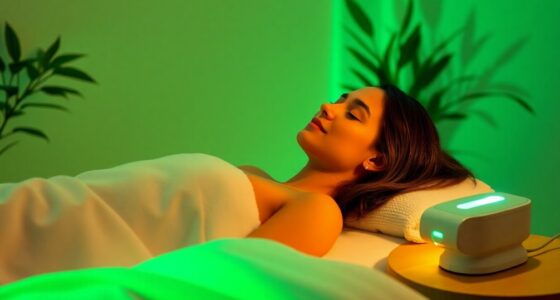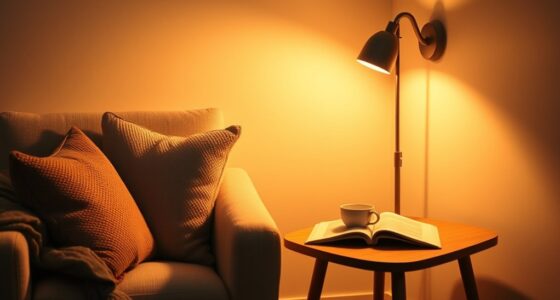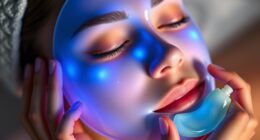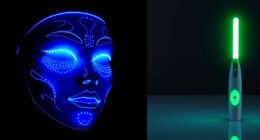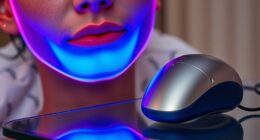After long travel or experiencing jet lag, using light therapy can help reset your internal clock and give your skin a boost. By exposing yourself to specific light wavelengths, you signal your body to adjust its circadian rhythm, which improves sleep and reduces stress-related skin issues like dullness and breakouts. Consistent use just after traveling accelerates recovery and restores your skin’s natural glow. If you want to discover more about optimizing this for your skin, keep exploring the options available.
Key Takeaways
- Use morning light therapy sessions to help reset your circadian rhythm and reduce jet lag symptoms.
- Light therapy stimulates vitamin D production, promoting skin repair and enhancing skin glow after travel.
- Regular exposure to specific light wavelengths balances hormones like melatonin and cortisol, supporting better sleep and skin health.
- Combining light therapy with good sleep, hydration, and skincare accelerates skin recovery from travel stress.
- Start light therapy promptly after arriving to facilitate quicker body and skin adaptation to new time zones.
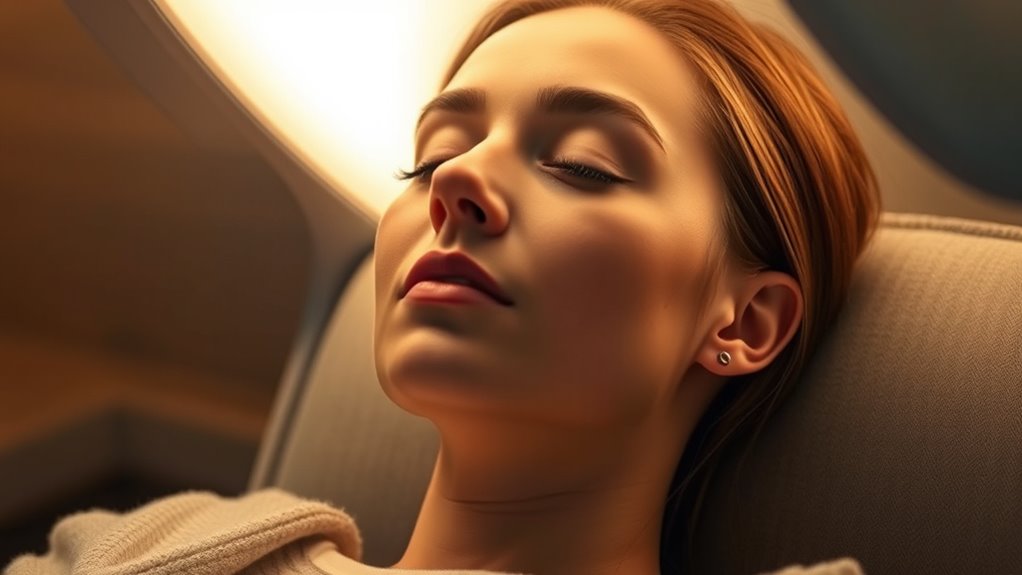
After traveling across time zones, your body often struggles to adjust to the new schedule, leading to fatigue, sleep disturbances, and decreased alertness. This disruption isn’t just about feeling tired; it affects your overall well-being, including your skin. The stress of jet lag can cause dullness, dryness, and even breakouts as your body’s internal clock tries to reset. Light therapy offers a practical way to help your skin recover and align with your new routine faster.
Light therapy works by exposing your skin and eyes to specific wavelengths of light that influence your body’s circadian rhythms. When you arrive in a new time zone, your internal clock is out of sync with the local day-night cycle. This mismatch hampers your body’s ability to produce hormones like melatonin, which regulates sleep, and cortisol, which affects stress and inflammation. By strategically using light therapy, you can signal to your body that it’s daytime, even if your internal clock is still on your previous schedule.
Using a light therapy device, you aim to mimic natural sunlight, which is especially beneficial if you’re traveling to a place with limited daylight or if your trip occurs during seasons with shorter days. The key is timing. In the morning, exposure to bright light can help advance your circadian rhythm, making you feel more alert during the day and promoting earlier sleep at night. Conversely, if you’re adjusting to a later schedule, evening light exposure can help delay your internal clock, helping you stay awake longer and reset more smoothly.
In addition to aiding sleep, light therapy can improve your skin’s appearance. Sunlight triggers the production of vitamin D, which plays a vital role in skin health, including its repair and regeneration processes. When your body gets the right amount of light, it can boost circulation and reduce inflammation, resulting in a brighter, more vibrant complexion. It can also help diminish dullness caused by disrupted sleep and stress, giving your skin a natural glow.
Furthermore, selecting a high-quality projector with proper light output and spectrum can enhance the effectiveness of your light therapy routine, ensuring optimal benefits for your skin and circadian adjustment. To incorporate light therapy into your post-travel routine, start with short sessions of about 20-30 minutes, ideally in the morning. Position the device at eye level, but avoid staring directly into the light to prevent eye strain. Consistency is key—using it daily for a few days after your trip helps your body and skin adjust more quickly. Remember, while light therapy is effective, it should complement good sleep hygiene, hydration, and a healthy skincare routine to maximize your recovery and refresh your skin after travel.
Frequently Asked Questions
Can Light Therapy Replace Traditional Jet Lag Remedies?
Light therapy can help ease jet lag by regulating your circadian rhythm and boosting alertness, but it shouldn’t replace traditional remedies like adjusting your sleep schedule, staying hydrated, or using melatonin. Use light therapy as a complementary tool to enhance your recovery, especially if you’re sensitive to time zone changes. Combining methods offers a more effective approach to resetting your internal clock and reducing jet lag symptoms.
How Soon Should I Start Light Therapy After Arriving?
You should start light therapy as soon as you arrive, ideally within the first hour of waking up, to help reset your internal clock. This quick action can accelerate your adjustment to the new time zone and boost your energy levels. Don’t wait too long, or your body might struggle to adapt. Consistency is key, so commit to daily sessions to see the best results.
Is Light Therapy Safe for All Skin Types?
Yes, light therapy is generally safe for all skin types, but it’s important to follow guidelines. You should start with shorter sessions and gradually increase exposure, especially if you have sensitive skin or certain medical conditions. Always consult a dermatologist before beginning, particularly if you have skin issues or are on medications that increase photosensitivity. Proper use mitigates risks and ensures you gain the benefits safely.
How Long Does It Take to See Results?
Ever wonder how soon you’ll notice a difference? Typically, you’ll start seeing improvements in your skin within 3 to 4 weeks of consistent light therapy sessions. Some people might see changes sooner, especially with daily use. Remember, everyone’s skin responds differently, so patience is key. Keep up with regular treatments, and you’ll likely enjoy a brighter, more refreshed complexion sooner than you think!
Are There Any Side Effects From Light Therapy?
You might experience mild side effects from light therapy, like eye strain, headaches, or skin irritation, but these are usually temporary. To mitigate risks, follow the recommended duration and distance from the light source. If you notice discomfort, reduce exposure or consult a healthcare professional. Most people tolerate light therapy well, but listening to your body helps ensure safe, effective results.
Conclusion
After your travels, incorporating light therapy can effectively reset your skin and energy levels. It’s a simple, natural way to combat jet lag and restore your glow. Did you know that up to 70% of travelers experience disrupted circadian rhythms? Using light therapy helps recalibrate your internal clock, making recovery faster and smoother. So next time you jet off, consider light therapy as your quick, effective skin and mood reset tool.
